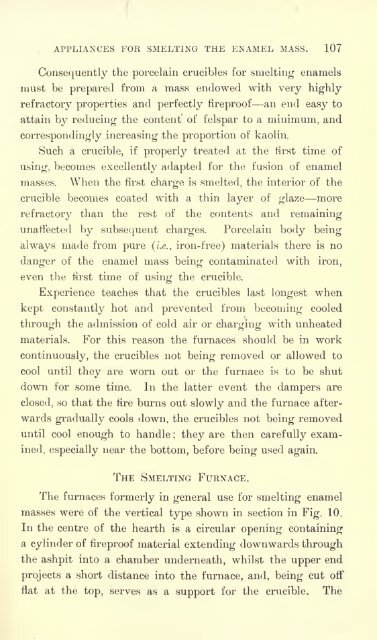Enamels and enamelling; an introduction to the preparation and ...
Enamels and enamelling; an introduction to the preparation and ...
Enamels and enamelling; an introduction to the preparation and ...
Create successful ePaper yourself
Turn your PDF publications into a flip-book with our unique Google optimized e-Paper software.
APPLIANCES FOE SMELTING THE ENAMEL MASS. 107<br />
Consequently <strong>the</strong> porcelain crucibles for smelting enamels<br />
must be prepared from a mass endowed with very highly<br />
refrac<strong>to</strong>ry properties <strong><strong>an</strong>d</strong> perfectly fireproof <strong>an</strong> end easy <strong>to</strong><br />
attain by reducing <strong>the</strong> content of felspar <strong>to</strong> a minimum, <strong><strong>an</strong>d</strong><br />
correspondingly increasing <strong>the</strong> proportion of kaolin.<br />
Such a crucible, if properly treated at <strong>the</strong> first time of<br />
using, becomes excellently adapted for <strong>the</strong> fusion of enamel<br />
masses. When <strong>the</strong> first charge is smelted, <strong>the</strong> interior of <strong>the</strong><br />
crucible becomes coated with a thin layer of glaze more<br />
refrac<strong>to</strong>ry th<strong>an</strong> <strong>the</strong> rest of <strong>the</strong> contents <strong><strong>an</strong>d</strong> remaining<br />
unaffected by subsequent charges. Porcelain body being<br />
always made from pure (i.e., iron-free) materials <strong>the</strong>re is no<br />
d<strong>an</strong>ger of <strong>the</strong> enamel mass being contaminated with iron,<br />
even <strong>the</strong> first time of using <strong>the</strong> crucible.<br />
Experience teaches that <strong>the</strong> crucibles last longest when<br />
kept const<strong>an</strong>tly hot <strong><strong>an</strong>d</strong> prevented from becoming cooled<br />
through <strong>the</strong> admission of cold air or charging with unheated<br />
materials. For this reason <strong>the</strong> furnaces should be in work<br />
continuously, <strong>the</strong> crucibles not being removed or allowed <strong>to</strong><br />
cool until <strong>the</strong>y are worn out or <strong>the</strong> furnace is <strong>to</strong> be shut<br />
down for some time. In <strong>the</strong> latter event <strong>the</strong> dampers are<br />
closed, so that <strong>the</strong> fire burns out slowly <strong><strong>an</strong>d</strong> <strong>the</strong> furnace afterwards<br />
gradually cools down, <strong>the</strong> crucibles not being removed<br />
until cool enough <strong>to</strong> h<strong><strong>an</strong>d</strong>le ; <strong>the</strong>y are <strong>the</strong>n carefully exam-<br />
ined, especially near <strong>the</strong> bot<strong>to</strong>m, before being used again.<br />
THE SMELTING FURNACE.<br />
The furnaces formerly in general use for smelting enamel<br />
masses were of <strong>the</strong> vertical type shown in section in Fig. 10.<br />
In <strong>the</strong> centre of <strong>the</strong> hearth is a circular opening containing<br />
a cylinder of fireproof material extending downwards through<br />
<strong>the</strong> ashpit in<strong>to</strong> a chamber underneath, whilst <strong>the</strong> upper end<br />
projects a short dist<strong>an</strong>ce in<strong>to</strong> <strong>the</strong> furnace, <strong><strong>an</strong>d</strong>, being cut off<br />
flat at <strong>the</strong> <strong>to</strong>p, serves as a support for <strong>the</strong> crucible. The
















